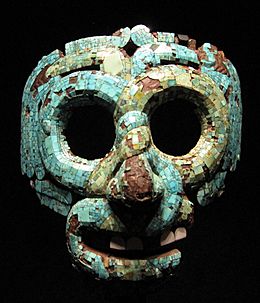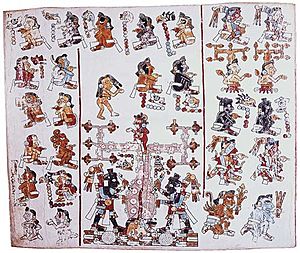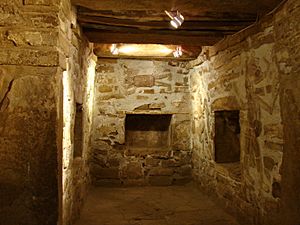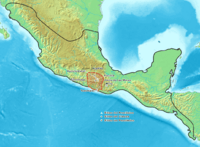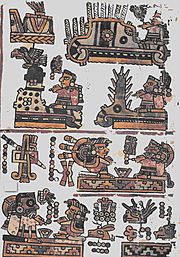Mixtec facts for kids
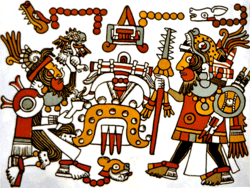
Mixtec king and warlord Eight Deer Jaguar Claw (right) Meeting with Four Jaguar, in a depiction from the pre-Columbian Codex Zouche-Nuttall.
|
|
| Total population | |
|---|---|
| Approximately 830,000 | |
| Regions with significant populations | |
| Mexico ( |
|
| Languages | |
| Mixtec, Spanish | |
| Religion | |
| Roman Catholicism with elements of traditional beliefs | |
| Related ethnic groups | |
| Zapotecs, Trique |
The Mixtecs are a group of native people from Mexico. They live in a region called La Mixteca. This area is mostly in the states of Oaxaca, Puebla, and Guerrero. The Mixtec culture was very important in this region. It lasted from about 1500 BC until the Spanish arrived in 1523.
The Mixtec land has three main parts based on its geography. These are the Mixteca Alta (Highlands), the Mixteca Baja (Lowlands), and the Mixteca Costa (Coast). The Highlands are dry and mountainous. The Lowlands are hot and dry, but at a lower elevation. The Coast is also low but much more humid and tropical.
Archaeologists have studied the Highlands the most. They found signs of people living there since ancient times. The first cities in the Mixtec region grew in the Highlands. People in the Lowlands were probably more like their neighbors in Guerrero. They even had their own writing system called ñuiñe. The Coast became part of the Mixtec lands later. This happened during the military trips of a famous Mixtec leader. His name was Eight Deer Jaguar Claw.
Before the Spanish arrived, many Mixtec kingdoms existed. They often fought or made alliances with each other. They also interacted with Zapotec kingdoms. In the 16th century, the Spanish conquered the Mixtec people. Before this, about 1.5 million Mixtecs lived in the area. Today, around 800,000 Mixtec people live in Mexico. Many also live in the United States. The Mixtec languages are part of a larger language family.
Contents
What Does "Mixtec" Mean?
The name Mixtec comes from a word in the Nahuatl language. That word is mixtecah, which means "cloud people." The Mixtecs have many names for themselves. These include ñuù savi and nayívi savi. All these names can be translated as 'the land of the rain'.
Their homeland, La Mixteca, is called Ñuu Savi in their language. This name also means 'land of the rain'. They call their language sa'an davi or tu'un savi.
Mixtec History and Culture
In ancient times, the Mixtec were one of the most important cultures in Mesoamerica. Some of their major ancient cities were Tilantongo, Achiutla, and Tututepec. The Mixtec also built important structures at Monte Albán. This city was first built by the Zapotec people. Later, the Mixtec took control of it.
Mixtec artists were very skilled. They created beautiful things from stone, wood, and metal. Their work was admired across ancient Mesoamerica. They were especially known for being excellent goldsmiths. They used a special method called lost-wax casting to make gold jewelry.
When the Aztec Empire was powerful, many Mixtec towns paid tribute to the Aztecs. This meant they gave goods or services to the Aztecs. However, not all Mixtec towns became part of the Aztec Empire. The Mixtecs resisted Spanish rule for a while. But they were eventually conquered by the Spanish and their allies.
Today, many Mixtecs have moved to different parts of Mexico and the United States. In recent years, many native people from Oaxaca have moved to the U.S. The Mixtec are now one of the largest groups of Native Americans in the United States. Large Mixtec communities live in cities like Tijuana, San Diego, and Tucson. These communities often keep strong ties between their homes in Mexico and their new homes.
Mixtecs in the Colonial Era
After the Spanish arrived, the Mixtec people faced many changes. Spanish rule affected their way of life. However, Mixtec people continued to keep their culture alive. They also kept some of their traditions.
During this time, some Mixtec leaders, called caciques, worked with the Spanish. But many Mixtec people also fought for their rights. They tried to keep their land and traditions.
Mixtec Lands and Regions
The Mixtec area is mainly in the western part of Oaxaca. Some Mixtec communities also live in Puebla and Guerrero. As mentioned before, the Mixtec homeland is divided into three main areas. These are the Mixteca Alta (Highland Mixtec), the Mixteca Baja (Lowland Mixtec), and the Mixteca de la Costa (Coastal Mixtec).
The Mixteca Alta was often the most powerful region. The main cities of the Mixtec nation were in these central highlands. The Valley of Oaxaca was a border area. Sometimes the Mixtec controlled it, and sometimes their neighbors, the Zapotec, did. An ancient cave site called the Colossal Natural Bridge is a very important sacred place for the Mixtec people.
Language, Ancient Books, and Art
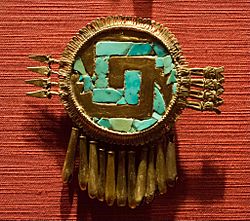
Many different types of Mixtecan languages are spoken. At the end of the 20th century, about 300,000 people spoke them. Most Mixtec speakers also know some Spanish. Some Mixtecan languages have different names, like Cuicatec and Triqui.
The Mixtec are famous for their ancient books, called Codices. These are like phonetic pictures. They wrote their history and family trees in these books. They used deerskin and folded the books like an accordion.
One of the most famous stories in the Mixtec Codices is about Lord Eight Deer Jaguar Claw. He was named after the day he was born. His personal name was Jaguar Claw. His amazing story is told in several codices, like the Codex Bodley and Codex Zouche-Nuttall. He was a powerful leader who united most of the Mixteca region.
The Mixtec were also known for their beautiful jewelry and mosaics. They often used gold and turquoise. The gold items made by Mixtec artists were an important part of the tribute they paid to the Aztecs. Turquoise mosaic masks were also very important. They were used as gifts to make alliances. People wore them in ceremonies to pretend to be a god. These masks were also placed on special bundles for the dead.
See also
 In Spanish: Pueblo mixteco para niños
In Spanish: Pueblo mixteco para niños


